The sighting of five Chinese navy ships near Alaska demonstrates China’s desire to be a major player in Arctic affairs. This action is part of a larger effort by China to demonstrate its naval presence around the world.
FACTS:
On September 2, Pentagon officials reported the presence of five Chinese navy ships in international waters off the coast of Alaska. Two days later, it was revealed that although the ships did enter American waters, they were passing through in accordance with international norms. This marks the first time Chinese military ships have been located in the area. In addition, the timing occurs as China is expanding its interests in the Arctic, having joined the Arctic Council as a permanent observer in 2013. Beijing has heavily invested in its navy in an attempt to build and maintain a blue-water navy, forces capable of sustaining operations over a long distance for an extended period of time. The ships were also located in the Arctic at the same time as U.S. President Barack Obama wrapped up a visit to Alaska in order to shine a light on the challenges of climate change. At this time, American officials are unsure what the Chinese vessels were doing in the area and whether or not their presence was timed to coincide with Obama’s visit.
ANALYSIS:
The above example is just one part of a pattern of expanded Chinese naval activity around the world, including but not limited to anti-piracy efforts off the coast of East Africa, increased naval activity in the South China Sea, and a recent joint training exercise with Russia off its Pacific coast. These are all cases in which China is demonstrating to the world that it wants to be considered a player on the world stage. After investing heavily in its navy, China is now showing it off, similar to Teddy Roosevelt ordering the U.S. Navy’s Great White Fleet to circumnavigate the globe in 1907. Prior to Roosevelt's order, the United States was previously a minor player in the world, with a relatively small navy. The circumnavigation told the world otherwise.
China’s naval growth will not take the exact same path as the United States' once did, and five ships off the coast of Alaska are neither a major threat nor illegal. The Pentagon states that it respects “the freedom of all nations to operate military vessels in international waters.” Of particular note is China’s interest in a northern sea route through the Arctic. As climate change continues to impact the region and facilitates easier navigation of the Arctic, China will be able to trade on this shorter and less expensive route to Europe. China has expressed interest in exploiting this route in partnership with Russia and has invested in ice breaking ships as well. The recent patrol of Chinese ships all the way to the coast of Alaska is most likely an exercise with future Arctic expeditions in mind.
PROJECTION:
Despite recent hiccups in the Chinese economy, it still has plenty of room to grow in the long run, and with that inevitable growth will come further expansion in international trade. As Arctic sea ice continues to melt, making trade routes and resources more accessible, many countries will seek to take advantage of the economic opportunity this presents, and China is no exception. Therefore, China will continue to invest in blue-water naval capabilities in order to protect its interests in this inhospitable region of the world. With this investment will likely come additional Chinese ships near Alaska and the rest of the Arctic.


No comments:
Post a Comment
Comments always welcome!